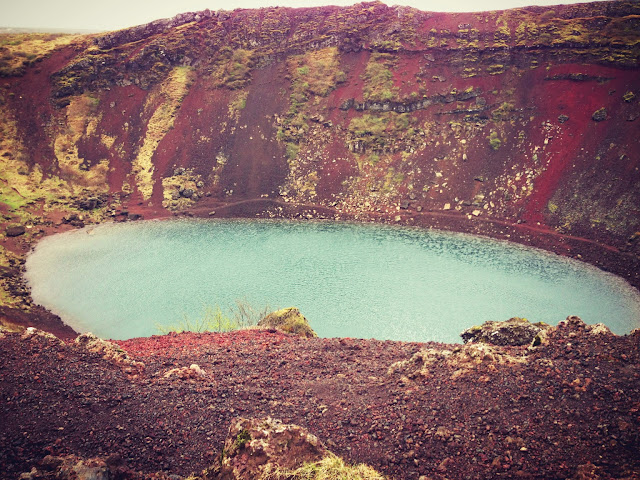Our last sightseeing day in Iceland this time was a tour to the western Iceland and the fjords north of Reykjavik.

On
Route 1 we first went through the tunnel under
Hvalfjørdur. It is 5,770 m long and reaches depth of 165m below sea level.
Route 1 is going around Iceland and connect the most interesting parts of the country. The length is 1.339 km

The landscape on Route 1 is beautiful and this scenery is just like a motive for a painting by Thore Heramb or maybe myself. We also crossed the Borgarfjørdur on Borgarfjarðarbrú which is the second longest bridge in Iceland, after Skeiðarárbrú. It spans 520 m

We had a break for lunch in Borgarnes and visited the Settlement centre where the life of
Egill Skallagrimsson is covered. You can learn about his life in
Egils Saga.
Borgarnes is first noted in Egils Saga, where it is called Digranes. The first Settler to live there was called Grani, a shipmate of Skallagrímur, the first landlord and settler of the Borgarfjörður-area.
I think you should make special attention to the colors of the roofs on the image above. Picturesque?

From Borgarnes we headed toward Reykholt but made a stop at
Deildartunguhver which is a hotspring in Reykholtsdalur. It is characterized by a very high flow rate for a hot spring (180 liters/second) and water emerges at 97 °C. It is the highest-flow hot spring in Europe, and comes just out of a hole in the wall.
Some of the water is used for heating, being piped 34 kilometers to Borgarnes and 64 kilometers to Akranes.

The valley around Reykholt has an open u-formed shape which is common from the withdrawal of the ice cups. In the middle of the valley Snorre Sturlasson´s home is located.

We did not stop at Reykholt, but continued however up the valley. About 20 km from Reykholt, there are the lava waterfalls
Hraunfossar, one of the most interesting natural wonders on the island.

From this area we can see an arm of
Langjøkull the second largest ice cap in Iceland (953 km2) Langjøkull is also giving water to Gullfoss and the Thingvella-lake described in a previous blogpost from Iceland. After this visit we returned to Reykholt.


Every Norwegian and Icelander know
Snorri Sturlason ( any facial similarity to the editor of this blog is random)
Snorri was known as a poet, but was also a successful lawyer. In 1215, he became lawspeaker of the Althing, the only public office of the Icelandic commonwealth and a position of high respect. In the summer of 1218, he left the lawspeaker position and sailed to Norway, by royal invitation.
Snorri Sturluson most famous works are Heimskringla (facsimile above) and (the Younger) Edda, and it is speculated that he also wrote Egils saga.
Heimskringla (ca. 1220-1235) is a collection of sagas - a history that is about the Norwegian kings of Halfdan the Black (850), Olav Tryggvason and of King Sverre (1177). The work is named after the opening words of the work, Kringla Heimsins (= the round earth album). Heimskringla has meant very much to create a Norwegian national feeling.
Snorri's Edda (ca. 1220-1230), also known as the Younger Edda, is a textbook or manual of poetry (not to be confused with the Elder Edda). It is about the Norse god myths surrounding among others Odin and Thor. The book starts with a prologue in which the creation is described along with religion origins and genesis of the old gods, the Aesir.
In addition, it has been proposed as a theory that Egils saga (1226) also was written by Snorri, but it is not yet proven. It is a saga of Egil Skallagrimson. The action takes place in the period 850-1000, mostly in Norway and Iceland. The saga of Eigil is visualized at the Settlement Centre in Borgarnes.

According to "Landnamabok" a hot bath was used at Reykholt already in the 10th century.
In Sturlungasaga the hot bath is mentioned several times. The bath at Reykholt is approximately 4 m in diameter and as a depth about 1m. A passage leads from the old "Snorri-stugu" to the bath, and the story tells that Snorre was killed in this passage 23 september 1241

Instead of taking the underwater-tunnel on our way back to Reykjavik, we travelled over the Skardsheidi and followed the road around the Hvalfjørdur. A beautiful and different road.

At a break we could see the photo of a Fin whale with a jaw bone in front. The dimension is clear.

At all the tour of day 4 was a different way of experiencing Iceland, and the beauty of Hvalfjørdur in the late afternoon will remain in our memories.





















































